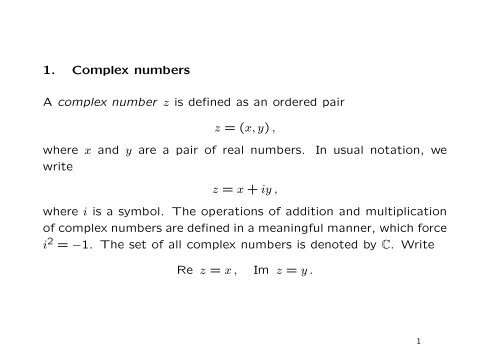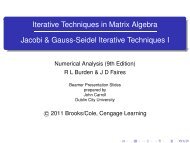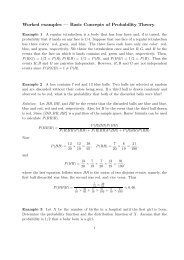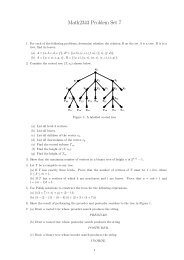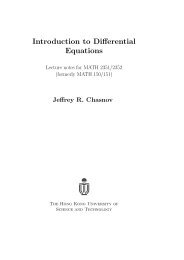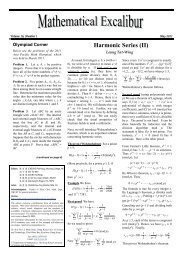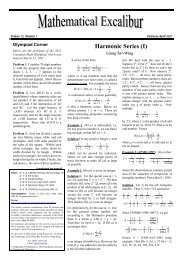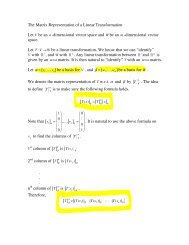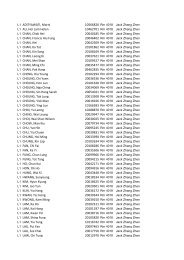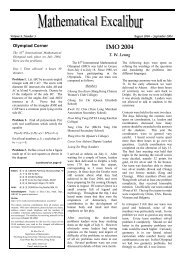1. Complex numbers A complex number z is defined as an ordered ...
1. Complex numbers A complex number z is defined as an ordered ...
1. Complex numbers A complex number z is defined as an ordered ...
You also want an ePaper? Increase the reach of your titles
YUMPU automatically turns print PDFs into web optimized ePapers that Google loves.
<strong>1.</strong> <strong>Complex</strong> <strong><strong>number</strong>s</strong><br />
A <strong>complex</strong> <strong>number</strong> z <strong>is</strong> <strong>defined</strong> <strong>as</strong> <strong>an</strong> <strong>ordered</strong> pair<br />
z = (x, y) ,<br />
where x <strong>an</strong>d y are a pair of real <strong><strong>number</strong>s</strong>. In usual notation, we<br />
write<br />
z = x + iy ,<br />
where i <strong>is</strong> a symbol. The operations of addition <strong>an</strong>d multiplication<br />
of <strong>complex</strong> <strong><strong>number</strong>s</strong> are <strong>defined</strong> in a me<strong>an</strong>ingful m<strong>an</strong>ner, which force<br />
i 2 = −<strong>1.</strong> The set of all <strong>complex</strong> <strong><strong>number</strong>s</strong> <strong>is</strong> denoted by C. Write<br />
Re z = x , Im z = y .<br />
1
Since <strong>complex</strong> <strong><strong>number</strong>s</strong> are <strong>defined</strong> <strong>as</strong> <strong>ordered</strong> pairs, two <strong>complex</strong><br />
<strong><strong>number</strong>s</strong> (x1, y1) <strong>an</strong>d (x2, y2) are equal if <strong>an</strong>d only if both their real<br />
parts <strong>an</strong>d imaginary parts are equal. Symbolically,<br />
(x1, y1) = (x2, y2) if <strong>an</strong>d only if x1 = x2 <strong>an</strong>d y1 = y2 .<br />
A <strong>complex</strong> <strong>number</strong> z = (x, y), or <strong>as</strong> z = x + iy, <strong>is</strong> <strong>defined</strong> by a pair<br />
of real <strong><strong>number</strong>s</strong> x <strong>an</strong>d y; so does for a point (x, y) in the x-y pl<strong>an</strong>e.<br />
We <strong>as</strong>sociate a one-to-one correspondence between the <strong>complex</strong><br />
<strong>number</strong> z = x + iy <strong>an</strong>d the point (x, y) in the x-y pl<strong>an</strong>e. We refer<br />
the pl<strong>an</strong>e <strong>as</strong> the <strong>complex</strong> pl<strong>an</strong>e or z-pl<strong>an</strong>e.<br />
2
Polar coordinates<br />
Modulus of z : |z| = r =<br />
x = rcos θ <strong>an</strong>d y = rsin θ<br />
y<br />
|z|<br />
<br />
x 2 + y 2 .<br />
arg z<br />
z = ( x,<br />
y)<br />
Vectorical representation of a <strong>complex</strong> <strong>number</strong> in the <strong>complex</strong> pl<strong>an</strong>e<br />
x<br />
3
Obviously, Re z ≤ |z| <strong>an</strong>d Im z ≤ |z|; <strong>an</strong>d<br />
z = x + iy = r(cos θ + <strong>is</strong>in θ),<br />
where θ <strong>is</strong> called the argument of z, denoted by arg z.<br />
The principal value of arg z, denoted by Arg z, <strong>is</strong> the particular value<br />
of arg z chosen within the principal interval (−π, π]. We have<br />
arg z = Arg z + 2kπ k <strong>an</strong>y integer, Arg z ∈ (−π, π] .<br />
Note that arg z <strong>is</strong> a multi-valued function.<br />
4
<strong>Complex</strong> conjugate<br />
The <strong>complex</strong> conjugate z of z = x + iy <strong>is</strong> <strong>defined</strong> by<br />
z = x − iy .<br />
In the <strong>complex</strong> pl<strong>an</strong>e, the conjugate z = (x, −y) <strong>is</strong> the reflection of<br />
the point z = (x, y) with respect to the real ax<strong>is</strong>.<br />
St<strong>an</strong>dard results on conjugates <strong>an</strong>d moduli<br />
(i) z1 + z2 = z1 + z2, (ii) z1z2 = z1 z2, (iii) z1<br />
(iv) |z1z2| = |z1| |z2| (v)<br />
<br />
<br />
z1<br />
<br />
<br />
<br />
z2<br />
<br />
|z1|<br />
=<br />
|z2| .<br />
z2<br />
= z1<br />
,<br />
z2<br />
5
Example<br />
Find the square roots of a + ib, where a <strong>an</strong>d b are real const<strong>an</strong>ts.<br />
Solution<br />
Let u + iv be a square root of a + ib; <strong>an</strong>d so (u + iv) 2 = a + ib.<br />
Equating the corresponding real <strong>an</strong>d imaginary parts, we have<br />
u 2 − v 2 = a <strong>an</strong>d 2uv = b .<br />
By eliminating v, we obtain a fourth degree equation for u:<br />
4u 4 − 4au 2 − b 2 = 0 .<br />
The two real roots for u are found to be<br />
<br />
<br />
<br />
a +<br />
u = ±<br />
<br />
a 2 + b 2<br />
2<br />
.<br />
6
From the relation v 2 = u 2 − a, we obtain<br />
v = ±<br />
<br />
<br />
<br />
a2 + b2 − a<br />
Apparently, there are four possible values for u+iv. However, there<br />
c<strong>an</strong> be only two values of the square root of a+ib. By virtue of the<br />
relation 2uv = b, one must choose u <strong>an</strong>d v such that their product<br />
h<strong>as</strong> the same sign <strong>as</strong> b. Th<strong>is</strong> leads to<br />
u + iv = ±<br />
⎛<br />
<br />
<br />
⎜<br />
⎝<br />
a +<br />
<br />
a 2 + b 2<br />
2<br />
2<br />
+ i b<br />
|b|<br />
.<br />
<br />
<br />
<br />
<br />
⎞<br />
a2 + b2 − a ⎟<br />
⎠<br />
2<br />
,<br />
provided that b = 0. The special c<strong>as</strong>e where b = 0 <strong>is</strong> trivial. As a<br />
numerical example, take a = 3, b = −4, then<br />
±<br />
⎛<br />
⎝<br />
3 + 5<br />
2<br />
− i<br />
<br />
⎞<br />
5 − 3<br />
⎠ = ±(2 − i).<br />
2<br />
7
De’ Moivre’s theorem<br />
Any <strong>complex</strong> <strong>number</strong> with unit modulus c<strong>an</strong> be expressed <strong>as</strong> cos θ+<br />
<strong>is</strong>in θ. By virtue of the <strong>complex</strong> exponential function ∗ , we have<br />
e iθ = cos θ + <strong>is</strong>in θ.<br />
The above formula <strong>is</strong> called the Euler formula. As motivated by the<br />
Euler formula, one may deduce that<br />
(cos θ + <strong>is</strong>in θ) n = (e iθ ) n = e inθ = cos nθ + <strong>is</strong>in nθ,<br />
where n c<strong>an</strong> be <strong>an</strong>y positive integer.<br />
∗ The <strong>complex</strong> exponential function <strong>is</strong> <strong>defined</strong> by<br />
e z = e x+iy = e x (cos y + <strong>is</strong>in y), z = x + iy.<br />
8
To prove the theorem, we consider the following c<strong>as</strong>es:<br />
(i) The theorem <strong>is</strong> trivial when n = 0.<br />
(ii) When n <strong>is</strong> a positive integer, the theorem c<strong>an</strong> be proven e<strong>as</strong>ily<br />
by mathematical induction.<br />
(iii) When n <strong>is</strong> a negative integer, let n = −m where m <strong>is</strong> a positive<br />
integer. We then have<br />
(cos θ + <strong>is</strong>in θ) n 1<br />
1<br />
=<br />
=<br />
(cos θ + <strong>is</strong>in θ) m cos mθ + <strong>is</strong>in mθ<br />
cos mθ − <strong>is</strong>in mθ<br />
=<br />
(cos mθ + <strong>is</strong>in mθ)(cos mθ − <strong>is</strong>in mθ)<br />
= cos mθ − <strong>is</strong>in mθ = cos nθ + <strong>is</strong>in nθ.<br />
9
How do we generalize the formula to (cos θ + <strong>is</strong>in θ) s , where s <strong>is</strong> a<br />
rational <strong>number</strong>?<br />
Let s = p/q, where p <strong>an</strong>d q are irreducible integers. Note that the<br />
modulus of cos θ+<strong>is</strong>in θ <strong>is</strong> one, so does (cos θ+<strong>is</strong>in θ) s . Hence, the<br />
polar representation of (cos θ+ <strong>is</strong>in θ) s takes the form cos φ+<strong>is</strong>in φ<br />
for some φ. Now, we write<br />
cos φ + <strong>is</strong>in φ = (cos θ + <strong>is</strong>in θ) s = (cos θ + <strong>is</strong>in θ) p/q .<br />
Taking the power of q of both sides<br />
cos qφ + <strong>is</strong>in qφ = cos pθ + <strong>is</strong>in pθ,<br />
10
which implies<br />
qφ = pθ + 2kπ or φ =<br />
pθ + 2kπ<br />
, k = 0,1, · · · , q − <strong>1.</strong><br />
q<br />
The value of φ corresponding to k that <strong>is</strong> beyond the above set<br />
of integers would be equal to one of those values <strong>defined</strong> in the<br />
equation plus some multiple of 2π.<br />
There are q d<strong>is</strong>tinct roots of (cos θ + <strong>is</strong>in θ) p/q , namely,<br />
<br />
pθ + 2kπ pθ + 2kπ<br />
cos + <strong>is</strong>in , k = 0,1, · · · , q − <strong>1.</strong><br />
q<br />
q<br />
11
n th root of unity<br />
By definition, <strong>an</strong>y n th roots of unity sat<strong>is</strong>fies the equation<br />
z n = 1 .<br />
By de’ Moivre’s theorem, the n d<strong>is</strong>tinct roots of unity are<br />
z = e i2kπ/n = cos 2kπ<br />
n<br />
2kπ<br />
+ <strong>is</strong>in , k = 0,1, ..., n − 1 .<br />
n<br />
If we write ωn = ei2π/n , then the n roots are 1, ωn, ω2 n , ..., ωn−1 n .<br />
Alternatively, if we pick <strong>an</strong>y one of the n th roots <strong>an</strong>d call it α, then<br />
the other n−1 roots are given by αωn, αω 2 n, ..., αω n−1<br />
n . Th<strong>is</strong> <strong>is</strong> obvious<br />
since each of these roots sat<strong>is</strong>fies<br />
(αω k n) n = α n (ω n n) k = 1, k = 0,1, · · · , n − <strong>1.</strong><br />
12
In the <strong>complex</strong> pl<strong>an</strong>e, the n roots of unity correspond to the n<br />
vertices of a regular n-sided polygon inscribed inside the unit circle,<br />
with one vertex at the point z = <strong>1.</strong> The vertices are equally spaced<br />
on the circumference of the circle. The successive vertices are<br />
obtained by incre<strong>as</strong>ing the argument by <strong>an</strong> equal amount of 2π/n<br />
of the preceding vertex.<br />
Suppose the <strong>complex</strong> <strong>number</strong> in the polar form <strong>is</strong> represented by<br />
r(cos φ + <strong>is</strong>in φ), its nth roots are given by<br />
r 1/n<br />
<br />
<br />
φ + 2kπ φ + 2kπ<br />
cos + <strong>is</strong>in , k = 0,1,2, ..., n − 1,<br />
n n<br />
where r 1/n <strong>is</strong> the real positive n th root of the real positive <strong>number</strong><br />
r. The roots are equally spaced along the circumference with one<br />
vertex being at r 1/n [cos(φ/n) + <strong>is</strong>in(φ/n)].<br />
13
Tri<strong>an</strong>gle inequalities<br />
For <strong>an</strong>y two <strong>complex</strong> <strong><strong>number</strong>s</strong> z1 <strong>an</strong>d z2, we c<strong>an</strong> establ<strong>is</strong>h<br />
|z1 + z2| 2 = (z1 + z2)(z1 + z2)<br />
= z1z1 + z2z2 + z1z2 + z2z1<br />
= |z1| 2 + |z2| 2 + 2Re(z1z2) .<br />
By observing that Re(z1z2) ≤ |z1z2|, we have<br />
|z1 + z2| 2 ≤ |z1| 2 + |z2| 2 + 2|z1z2|<br />
= |z1| 2 + |z2| 2 + 2|z1||z2| = (|z1| + |z2|) 2 .<br />
Since moduli are non-negative, we take the positive square root on<br />
both sides <strong>an</strong>d obtain<br />
|z1 + z2| ≤ |z1| + |z2| .<br />
14
To prove the other half of the tri<strong>an</strong>gle inequalities, we write<br />
giving<br />
|z1| = |(z1 + z2) + (−z2)| ≤ |z1 + z2| + | − z2|<br />
|z1| − |z2| ≤ |z1 + z2| .<br />
By interch<strong>an</strong>ging z1 <strong>an</strong>d z2 in the above inequality, we have<br />
Combining all results together<br />
<br />
<br />
<br />
<br />
|z2| − |z1| ≤ |z1 + z2| .<br />
<br />
<br />
<br />
|z1| − |z2| <br />
≤ |z1 + z2| ≤ |z1| + |z2|.<br />
15
Example<br />
Find <strong>an</strong> upper bound for |z 5 − 4| if |z| ≤ <strong>1.</strong><br />
Solution<br />
Applying the tri<strong>an</strong>gle inequality, we get<br />
|z 5 − 4| ≤ |z 5 | + 4 = |z| 5 + 4 ≤ 1 + 4 = 5,<br />
since |z| ≤ <strong>1.</strong> Hence, if |z| ≤ 1, <strong>an</strong> upper bound for |z 5 − 4| <strong>is</strong> 5.<br />
In general, the tri<strong>an</strong>gle inequality <strong>is</strong> considered <strong>as</strong> a crude inequality,<br />
which me<strong>an</strong>s that it will not yield le<strong>as</strong>t upper bound estimate. C<strong>an</strong><br />
we find a <strong>number</strong> smaller th<strong>an</strong> 5 that <strong>is</strong> also <strong>an</strong> upper bound, or <strong>is</strong><br />
5 the le<strong>as</strong>t upper bound?<br />
Yes, we may use the Maximum Modulus Theorem (to be d<strong>is</strong>cussed<br />
later). The upper bound of the modulus will correspond to a <strong>complex</strong><br />
<strong>number</strong> that lies on the boundary, where |z| = <strong>1.</strong><br />
16
Example<br />
For a non-zero z <strong>an</strong>d −π < Arg z ≤ π, show that<br />
Solution<br />
|z − 1| ≤<br />
|z − 1| ≤<br />
since (cos θ−1) 2 +sin 2 θ =<br />
<strong>an</strong>d<br />
<br />
<br />
<br />
<br />
<br />
<br />
<br />
θ <br />
sin <br />
2<br />
≤<br />
<br />
<br />
<br />
<br />
<br />
<br />
<br />
<br />
<br />
<br />
|z| − 1<br />
<br />
<br />
<br />
<br />
<br />
+|z| |Arg z|.<br />
<br />
<br />
<br />
<br />
<br />
<br />
z<br />
− |z| + (|z| − 1) <br />
≤<br />
<br />
<br />
<br />
<br />
<br />
<br />
<br />
<br />
= |z| |cos θ + <strong>is</strong>in θ − 1| + <br />
<br />
<br />
= |z| (cos θ − 1) 2 + sin 2 <br />
<br />
<br />
θ + <br />
<br />
<br />
<br />
θ<br />
<br />
= |z| 2sin<br />
<br />
+<br />
<br />
<br />
<br />
|z|<br />
− 1<br />
<br />
<br />
<br />
θ<br />
<br />
2<br />
.<br />
2<br />
<br />
1 − 2sin<br />
2 θ<br />
2<br />
z − |z| <br />
+<br />
<br />
<br />
<br />
<br />
<br />
<br />
<br />
<br />
<br />
<br />
|z| − 1<br />
|z| − 1<br />
|z| − 1<br />
≤ |z||Arg z| +<br />
2<br />
− 1<br />
<br />
<br />
<br />
<br />
<br />
, θ = Arg z<br />
<br />
<br />
<br />
<br />
<br />
<br />
<br />
<br />
<br />
<br />
<br />
<br />
<br />
|z| − 1<br />
,<br />
+ 4sin<br />
2 θ<br />
2<br />
cos2 θ<br />
2<br />
= 4sin2 θ<br />
2<br />
17
Take |z| > 1 <strong>as</strong> <strong>an</strong> illustration<br />
Geometric interpretation: Consider the tri<strong>an</strong>gle whose vertices are<br />
1, z <strong>an</strong>d |z|, by the Tri<strong>an</strong>gle Inequality, we have<br />
|z − 1| ≤<br />
<br />
<br />
<br />
<br />
<br />
<br />
<br />
<br />
<br />
<br />
<br />
<br />
<br />
<br />
<br />
<br />
|z| − 1<br />
+ z − |z| <br />
.<br />
The chord joining |z| <strong>an</strong>d z <strong>is</strong> always shorter th<strong>an</strong> the circular arc<br />
joining the same two points. Note that the arc length <strong>is</strong> given by<br />
|z| |Arg z|.<br />
18
Geometric applications<br />
How to find the equation of the perpendicular b<strong>is</strong>ector of the line<br />
segment joining the two points z1 <strong>an</strong>d z2? Since <strong>an</strong>y point z on<br />
the b<strong>is</strong>ector will be equid<strong>is</strong>t<strong>an</strong>t from z1 <strong>an</strong>d z2, the equation of the<br />
b<strong>is</strong>ector c<strong>an</strong> be represented by<br />
|z − z1| = |z − z2| .<br />
For a given equation f(x, y) = 0 of a geometric curve, if we set<br />
x = (z + z)/2 <strong>an</strong>d y = (z − z)/2i, the equation c<strong>an</strong> be expressed in<br />
terms of the pair of conjugate <strong>complex</strong> variables z <strong>an</strong>d z <strong>as</strong><br />
<br />
z + z z − z<br />
f(x, y) = f , = F(z, z) = 0 .<br />
2 2i<br />
For example, the unit circle centered at the origin <strong>as</strong> represented by<br />
the equation x2 + y2 = 1 c<strong>an</strong> be expressed <strong>as</strong> zz = <strong>1.</strong><br />
19
Further examples<br />
(i) The set {z : |z − a| < r}, a ∈ C, r ∈ R, represents the set of points<br />
inside the circle centered at a with radius r but excluding the<br />
boundary.<br />
(ii) The set {z : r1 ≤ |z − a| ≤ r2}, a ∈ C, r1 ∈ R, r2 ∈ R, represents<br />
the <strong>an</strong>nular region centered at a <strong>an</strong>d bounded by circles of radii<br />
r1 <strong>an</strong>d r2. Here, the boundary circles are included.<br />
(iii) The set of points z such that |z − α| + |z − β| ≤ 2d, α <strong>an</strong>d β ∈ C<br />
<strong>an</strong>d d ∈ R, <strong>is</strong> the set of all points on or inside the ellipse with<br />
foci α <strong>an</strong>d β <strong>an</strong>d with length of semi-major ax<strong>is</strong> equals d. What<br />
<strong>is</strong> the length of the semi-minor ax<strong>is</strong>?<br />
20
Example<br />
Find the region in the <strong>complex</strong> pl<strong>an</strong>e that <strong>is</strong> represented by<br />
Solution<br />
0 < Arg<br />
z − 1<br />
z + 1<br />
< π<br />
4 .<br />
z − 1<br />
Let z = x + iy, <strong>an</strong>d consider Arg<br />
z + 1 = Arg x2 + y2 − 1 + 2iy<br />
(x + 1) 2 ,<br />
+ y2 whose value lies between 0 <strong>an</strong>d π/4 if <strong>an</strong>d only if the following<br />
3 conditions are sat<strong>is</strong>fied<br />
(i) x 2 + y 2 − 1 > 0, (ii) y > 0 <strong>an</strong>d (iii)<br />
These 3 conditions correspond to<br />
Re<br />
z − 1<br />
z + 1<br />
> 0, Im z − 1<br />
z + 1<br />
2y<br />
x 2 + y 2 − 1<br />
< <strong>1.</strong><br />
> 0 <strong>an</strong>d Arg z − 1<br />
z + 1<br />
< π<br />
4 .<br />
21
The l<strong>as</strong>t inequality c<strong>an</strong> be expressed <strong>as</strong> x 2 + (y − 1) 2 > 2. For<br />
y > 0, the region outside the circle: x 2 + (y − 1) 2 = 2 <strong>is</strong> contained<br />
completely inside the region outside the circle: x 2 + y 2 = <strong>1.</strong> Hence,<br />
the region represented by the above 3 inequalities <strong>is</strong><br />
R = {x + iy : x 2 + (y − 1) 2 > 2 <strong>an</strong>d y > 0}.<br />
Th<strong>is</strong> <strong>is</strong> the region which <strong>is</strong> outside the circle x 2 + (y − 1) 2 = 2 <strong>an</strong>d<br />
lying in the upper half-pl<strong>an</strong>e.<br />
22
Example<br />
If z1, z2 <strong>an</strong>d z3 represent the vertices of <strong>an</strong> equilateral tri<strong>an</strong>gle, show<br />
that<br />
Solution<br />
From the figure, we observe that<br />
Taking the div<strong>is</strong>ion<br />
so that<br />
z 2 1 + z2 2 + z2 3 = z1z2 + z2z3 + z3z<strong>1.</strong><br />
z2 − z1 = e iπ/3 (z3 − z1)<br />
z1 − z3 = e iπ/3 (z2 − z3).<br />
z2 − z1<br />
z1 − z3<br />
= z3 − z1<br />
z2 − z3<br />
z 2 1 + z2 2 + z2 3 = z1z2 + z2z3 + z3z<strong>1.</strong><br />
23
Example<br />
Suppose z1 + z2 + z3 = 0 <strong>an</strong>d |z1| = |z2| = |z3| = 1, show that<br />
z2 = ωz1 <strong>an</strong>d z3 = ω 2 z1,<br />
where ω <strong>is</strong> a root of the quadratic equation: z 2 + z + 1 = 0. Note<br />
that ω <strong>is</strong> a cube root of unity. Also, the other root <strong>is</strong> given by ω 2 .<br />
Hence, explain why z1, z2 <strong>an</strong>d z3 are the vertices of <strong>an</strong> equilateral<br />
tri<strong>an</strong>gle inscribed inside the unit circle: |z| = <strong>1.</strong><br />
Solution<br />
Since |z1| = |z2| = |z3| = 1, so z2 = e iα z1 <strong>an</strong>d z3 = e iβ z1, where α<br />
<strong>an</strong>d β are chosen within (−π, π]. Substituting into z1 + z2 + z3 = 0,<br />
we obtain<br />
e iα + e iβ + 1 = 0.<br />
24
Equating the respective real <strong>an</strong>d imaginary parts<br />
cos α + cos β + 1 = 0 <strong>an</strong>d sin α + sin β = 0,<br />
we obtain α = −β <strong>an</strong>d cos α = −1/2.<br />
Without loss of generality, we take α to be positive <strong>an</strong>d obtain<br />
α = 2π/3 <strong>an</strong>d β = −2π/3. Both e 2πi/3 <strong>an</strong>d e −2πi/3 are the roots of<br />
ω 2 + ω + 1 = 0. Indeed, one <strong>is</strong> the square of the other, <strong>an</strong>d vice<br />
versa.<br />
Suppose we write ω = e 2πi/3 , then ω 2 = e −2πi/3 . Hence, z2 = ωz1<br />
<strong>an</strong>d z3 = ω 2 z<strong>1.</strong> The 3 points z1, z2 <strong>an</strong>d z3 all lie on the unit circle<br />
|z| = 1 since |z1| = |z2| = |z3| = <strong>1.</strong><br />
25
Consider the tri<strong>an</strong>gle formed by these 3 points: z1, z3 <strong>an</strong>d z3. If z1 <strong>is</strong><br />
one vertex, then z2 <strong>is</strong> obtained by rotating the position vector of z1<br />
by 2π/3 in <strong>an</strong>ti-clockw<strong>is</strong>e sense. Likew<strong>is</strong>e, z3 <strong>is</strong> obtained by rotating<br />
the position vector of z2 by the same amount. Hence, z1, z2 <strong>an</strong>d<br />
z3 are the vertices of <strong>an</strong> equilateral tri<strong>an</strong>gle inscribed on the unit<br />
circle: |z| = <strong>1.</strong><br />
26
Symmetry with respect to a circle<br />
Given a point α in the <strong>complex</strong> pl<strong>an</strong>e, we would like to construct the<br />
symmetry point of α with respect to the circle C R : |z| = R. The<br />
symmetry point of α <strong>is</strong> <strong>defined</strong> to be β = R 2 /α. Conversely, since we<br />
may write α = R 2 /β, we c<strong>an</strong> <strong>as</strong> well consider α to be the symmetry<br />
point of β. The two points α <strong>an</strong>d β are said to be symmetric with<br />
respect to the circle C R.<br />
Construction of a pair of symmetric points with respect to the circle<br />
C R.<br />
27
Geometric properties of symmetric points<br />
(i) Assume that |α| < R <strong>an</strong>d so the inversion point β will be outside<br />
the circle C R. Observe that<br />
Arg β = Arg R2 1<br />
= Arg = -Arg α = Arg α,<br />
α α<br />
one concludes that α <strong>an</strong>d β both lie on the same ray em<strong>an</strong>ating<br />
from the origin.<br />
The inversion point β c<strong>an</strong> be constructed <strong>as</strong> follows: draw the<br />
circle C R <strong>an</strong>d a ray L from the origin through α. We then draw<br />
a perpendicular to L through α which intersects the circle C R<br />
at P. The point of intersection of the t<strong>an</strong>gent line to the circle<br />
C R at P <strong>an</strong>d the ray L then gives β. By the property of similar<br />
tri<strong>an</strong>gles, we have<br />
|β|<br />
R<br />
= R<br />
|α| .<br />
28
(ii) When |α| = R, the inversion point <strong>is</strong> just itself. Th<strong>is</strong> <strong>is</strong> because<br />
when |α| = R, we have |β| = R2<br />
|α|<br />
Arg α, we obtain β = α.<br />
= R. Together with Arg β =<br />
(iii) When |α| > R, the inversion point β will be inside the circle C R.<br />
In fact, α may be considered <strong>as</strong> the inversion point of β.<br />
To reverse the method of construction, we find a t<strong>an</strong>gent to the<br />
circle which p<strong>as</strong>ses through α <strong>an</strong>d call the point of t<strong>an</strong>gency P.<br />
A ray L <strong>is</strong> the drawn from the origin through α <strong>an</strong>d a perpendicular<br />
<strong>is</strong> dropped from P to L. The point of intersection of the<br />
perpendicular with the ray L then gives β.<br />
29
Limit points<br />
Neighborhood of z0, denoted by N(z0; ǫ), <strong>is</strong> <strong>defined</strong> <strong>as</strong><br />
N(z0; ǫ) = {z : |z − z0| < ǫ}.<br />
Sometimes, N(z0; ǫ) may be called <strong>an</strong> open d<strong>is</strong>c centered at z0 with<br />
radius ǫ. A deleted neighborhood of z0 <strong>is</strong> N(z0; ǫ)\{z0}. Write it <strong>as</strong><br />
N(z0; ǫ).<br />
A point z0 <strong>is</strong> a limit point or <strong>an</strong> accumulation point of a point set<br />
S if every neighborhood of z0 contains a point of S other th<strong>an</strong> z0.<br />
That <strong>is</strong>, N(z0; ǫ) ∩ S = φ, for <strong>an</strong>y ǫ.<br />
• Since th<strong>is</strong> <strong>is</strong> true for <strong>an</strong>y neighborhood of z0, S must contain<br />
infinitely m<strong>an</strong>y points. In other words, if S cons<strong>is</strong>ts of d<strong>is</strong>crete<br />
<strong>number</strong> of points, then there <strong>is</strong> no limit point of S.<br />
• A limit point z0 may or may not belong to the set S.<br />
30
Example<br />
Show that z = 1 <strong>is</strong> a limit point of the following point set:<br />
<br />
<br />
n n<br />
A = z : z = (−1) , n <strong>is</strong> <strong>an</strong> integer .<br />
n + 1<br />
Solution<br />
Given <strong>an</strong>y ǫ > 0, we w<strong>an</strong>t to show that there ex<strong>is</strong>ts one point in A<br />
other th<strong>an</strong> z = <strong>1.</strong> In fact, there ex<strong>is</strong>t <strong>an</strong> infinite <strong>number</strong> of points<br />
such that<br />
<br />
<br />
n <br />
<br />
(−1)n − 1<br />
< ǫ .<br />
n + 1<br />
If we choose n to be even <strong>an</strong>d positive <strong>an</strong>d n + 1 > 1<br />
, then<br />
<br />
ǫ<br />
<br />
n <br />
<br />
− 1<br />
< ǫ. Therefore, for <strong>an</strong>y ǫ, N(1; ǫ) contains at le<strong>as</strong>t one<br />
n<br />
+ 1 <br />
point in A other th<strong>an</strong> z = <strong>1.</strong><br />
31
Some topological definitions<br />
• A point z0 <strong>is</strong> called <strong>an</strong> interior point of a set S if there ex<strong>is</strong>ts a<br />
neighborhood of z0 with all of these points belong to S.<br />
• If every neighborhood of z0 contains points of S <strong>an</strong>d also points<br />
not belonging to S then z0 <strong>is</strong> called a boundary point.<br />
• The set of all boundary points of a set S <strong>is</strong> called the boundary<br />
of S. If a point <strong>is</strong> neither <strong>an</strong> interior nor a boundary point, then<br />
it <strong>is</strong> called <strong>an</strong> exterior point of S.<br />
Remark<br />
If z0 <strong>is</strong> not a boundary point, then there ex<strong>is</strong>ts a neighborhood of<br />
z0 such that it <strong>is</strong> completely inside S or completely outside S. In<br />
the former c<strong>as</strong>e, it <strong>is</strong> <strong>an</strong> interior point. In the latter c<strong>as</strong>e, it <strong>is</strong> <strong>an</strong><br />
exterior point.<br />
32
Example<br />
Show that the boundary of<br />
<strong>is</strong> the circle: |z − z0| = r.<br />
Solution<br />
Br(z0) = {z : |z − z0| < r}<br />
Pick a point z1 on the circle |z −z0| = r. Every d<strong>is</strong>k that <strong>is</strong> centered<br />
at z1 will contain (infinitely m<strong>an</strong>y) points in Br(z0) <strong>an</strong>d (infinitely<br />
m<strong>an</strong>y) points not in Br(z0). Hence, every point on the circle |z −<br />
z0| = r <strong>is</strong> a boundary point of Br(z0).<br />
33
No other points are boundary points<br />
• Since points inside the circle are interior points, they c<strong>an</strong>not be<br />
boundary points.<br />
• Given a point outside the circle, we c<strong>an</strong> enclose it in a d<strong>is</strong>k that<br />
does not intersect the d<strong>is</strong>k Br(z0). Hence, such a point <strong>is</strong> not<br />
boundary point.<br />
In th<strong>is</strong> example, none of the boundary points of Br(z0) belong to<br />
Br(z0).<br />
34
Open <strong>an</strong>d closed sets<br />
• A set which cons<strong>is</strong>ts only of interior points <strong>is</strong> called <strong>an</strong> open set.<br />
• Every point of <strong>an</strong> open set h<strong>as</strong> a neighborhood contained completely<br />
in the set.<br />
• A set <strong>is</strong> closed if it contains all its boundary points.<br />
• The closure S of a set S <strong>is</strong> the closed set cons<strong>is</strong>ting of all points<br />
in S together with the boundary of S.<br />
We may think of <strong>an</strong>y two-dimensional set without a boundary <strong>as</strong> <strong>an</strong><br />
open set. For example, the set S = {z : |z| < 1} <strong>is</strong> <strong>an</strong> open set. The<br />
closure S <strong>is</strong> the set {z : |z| ≤ 1}.<br />
35
Example<br />
The set R = {z : Re z > 0} <strong>is</strong> <strong>an</strong> open set. To see th<strong>is</strong>, for <strong>an</strong>y<br />
point w0 ∈ R; then σ0 = Re w0 > 0. Let ε = σ0/2 <strong>an</strong>d suppose that<br />
|z − w0| < ε. Then −ε < Re (z − w0) < ε <strong>an</strong>d so<br />
Re z = Re (z − w0) + Re w0 > −ε + σ0 = σ0/2 > 0.<br />
Consequently, z also lies in R. Hence, each point w0 of R <strong>is</strong> <strong>an</strong><br />
interior point <strong>an</strong>d so R <strong>is</strong> open.<br />
36
Theorem<br />
A set D <strong>is</strong> open if <strong>an</strong>d only if it contains no point of its boundary.<br />
Proof<br />
• Suppose that D <strong>is</strong> <strong>an</strong> open set, <strong>an</strong>d let P be a boundary point<br />
of D. If P <strong>is</strong> in D, then there <strong>is</strong> <strong>an</strong> open d<strong>is</strong>c centered at P that<br />
lies within D (since D <strong>is</strong> open). Hence, P <strong>is</strong> not in the boundary<br />
of D.<br />
• Suppose D <strong>is</strong> a set that contains none of its boundary points,<br />
for <strong>an</strong>y z0 ∈ D, z0 c<strong>an</strong>not be a boundary point of D. Hence,<br />
there <strong>is</strong> some d<strong>is</strong>c centered at z0 that <strong>is</strong> either a subset of D or<br />
a subset of the complement of D. The latter <strong>is</strong> impossible since<br />
z0 itself <strong>is</strong> in D. Hence, each point of D <strong>is</strong> <strong>an</strong> interior point so<br />
that D <strong>is</strong> open.<br />
37
Corollary<br />
A set C <strong>is</strong> closed if <strong>an</strong>d only if its complement D = {z : z ∈ C} <strong>is</strong><br />
open. To see the claim, we observe that the boundary of a set coincides<br />
exactly with the boundary of the complement of that set (<strong>as</strong> a<br />
direct consequence of the definition of boundary point). Recall that<br />
a closed set contains all its boundary points. Its complement shares<br />
the same boundary, but these boundary points are not contained in<br />
the complement, so the complement <strong>is</strong> open.<br />
Remark<br />
There are sets that are neither open nor closed since they contain<br />
part, but not all, of their boundary. For example,<br />
<strong>is</strong> neither open nor closed.<br />
S = {z : 1 < |z| ≤ 2}<br />
38
Theorem<br />
A set S <strong>is</strong> closed if <strong>an</strong>d only if S contains all its limit points.<br />
Proof<br />
Write N(z; ǫ) <strong>as</strong> the deleted ǫ-neighborhood of z, <strong>an</strong>d S ′ <strong>as</strong> the<br />
complement of S. Note that for z ∈ S, N(z; ǫ) ∩ S = N(z; ǫ) ∩ S.<br />
S <strong>is</strong> closed ⇔ S ′ <strong>is</strong> open<br />
⇔ given z ∈ S, there ex<strong>is</strong>ts ǫ > 0 such that N(z; ǫ) ⊂ S ′<br />
⇔ given z ∈ S, there ex<strong>is</strong>ts ǫ > 0 such that N(z; ǫ) ∩ S = φ<br />
⇔ no point of S ′ <strong>is</strong> a limit point of S<br />
39
Compact set<br />
• A bounded set S <strong>is</strong> one that c<strong>an</strong> be contained in a large enough<br />
circle centered at the origin, that <strong>is</strong>, |z| < M for some large<br />
enough const<strong>an</strong>t M for all points z in S where M <strong>is</strong> some sufficiently<br />
large const<strong>an</strong>t.<br />
• An unbounded set <strong>is</strong> one which <strong>is</strong> not bounded.<br />
• A set which <strong>is</strong> both closed <strong>an</strong>d bounded <strong>is</strong> called a compact set.<br />
40
Motivation for defining connectedness<br />
From b<strong>as</strong>ic calculus, if f ′ (x) = 0 for all x in (a, b), then f <strong>is</strong> a<br />
const<strong>an</strong>t.<br />
The above result <strong>is</strong> not true if the domain of definition of the<br />
function <strong>is</strong> not connected. For example<br />
f(x) =<br />
<br />
1 if 0 < x < 1<br />
−1 if 2 < x < 3 ,<br />
whose domain of definition <strong>is</strong> (0,1) ∪ (2,3). We have f ′ (x) = 0 for<br />
all x in (0,1) ∪ (2,3), but f <strong>is</strong> not const<strong>an</strong>t.<br />
Th<strong>is</strong> example illustrates the import<strong>an</strong>ce of connectedness in calculus.<br />
41
Domain <strong>an</strong>d region<br />
• An open set S <strong>is</strong> said to be connected if <strong>an</strong>y two points of S<br />
c<strong>an</strong> be joined by a continuous curve lying entirely inside S. For<br />
example, a neighborhood N(z0; ǫ) <strong>is</strong> connected.<br />
• An open connected set <strong>is</strong> called <strong>an</strong> open region or domain.<br />
• To the point set S, we add all of its limit points, then the new<br />
set S <strong>is</strong> the closure of S.<br />
• The closure of <strong>an</strong> open region <strong>is</strong> called a closed region.<br />
• To <strong>an</strong> open region we may add none, some or all its limit points,<br />
<strong>an</strong>d call the new set a region.<br />
42
Simply <strong>an</strong>d multiply connected domains<br />
Loosely speaking, a simply connected domain contains no holes, but<br />
a multiply connected domain h<strong>as</strong> one or more holes.<br />
43
• When <strong>an</strong>y closed curve <strong>is</strong> constructed in a simply connected<br />
domain, every point inside the curve lies in the domain.<br />
• It <strong>is</strong> always possible to construct some closed curve inside a<br />
multiply connected domain in such a way that one or more points<br />
inside the curve do not belong to the domain.<br />
44
<strong>Complex</strong> infinity<br />
• Unlike the real <strong>number</strong> system, which h<strong>as</strong> +∞ <strong>an</strong>d −∞, there <strong>is</strong><br />
only one infinity in the <strong>complex</strong> <strong>number</strong> system. Th<strong>is</strong> <strong>is</strong> because<br />
the <strong>complex</strong> <strong>number</strong> field C <strong>is</strong> not <strong>an</strong> <strong>ordered</strong> field ∗ . Recall that<br />
in the real <strong>number</strong> system, +∞ (−∞) <strong>is</strong> <strong>an</strong> upper (lower) bound<br />
of every subset of the extended real <strong>number</strong> system (set of all<br />
real <strong><strong>number</strong>s</strong> augmented with +∞ <strong>an</strong>d −∞).<br />
∗ C <strong>is</strong> not <strong>an</strong> <strong>ordered</strong> field c<strong>an</strong> be argued <strong>as</strong> follows. Suppose C <strong>is</strong> <strong>an</strong><br />
<strong>ordered</strong> field, then for <strong>an</strong>y non-zero x ∈ C, we must have either x or<br />
−x being positive, <strong>an</strong>d x 2 = (−x) 2 being positive. Consider i <strong>an</strong>d<br />
−i, we have i 2 = (−i) 2 = −1, which <strong>is</strong> negative. A contradiction<br />
<strong>is</strong> encountered.<br />
45
Extended <strong>complex</strong> pl<strong>an</strong>e<br />
It <strong>is</strong> convenient to augment the <strong>complex</strong> pl<strong>an</strong>e with the point at<br />
infinity, denoted by ∞. The set {C ∪ ∞} <strong>is</strong> called the extended<br />
<strong>complex</strong> pl<strong>an</strong>e. The algebra involving ∞ are <strong>defined</strong> <strong>as</strong> follows:<br />
z + ∞ = ∞ , for all z ∈ C<br />
z · ∞ = ∞ , for all z ∈ C/{0}<br />
z/∞ = 0 , for all z ∈ C<br />
z/0 = ∞ , for all z ∈ C/{0}.<br />
In particular, we have −1·∞ = ∞ <strong>an</strong>d expressions like 0·∞, ∞/∞, ∞±<br />
∞ <strong>an</strong>d 0/0 are not <strong>defined</strong>. Topologically, <strong>an</strong>y set of the form<br />
{z: |z| > R} where R ≥ 0 <strong>is</strong> called a neighborhood of ∞.<br />
• A set D contains the point at infinity if there <strong>is</strong> a large <strong>number</strong><br />
M such that D contains all the points z with |z| > M.<br />
46
Examples<br />
• The open half-pl<strong>an</strong>e Re z > 0 does not contain the point at<br />
infinity since it does not contain <strong>an</strong>y neighborhood of ∞.<br />
• The open set D = {z : |z + 1| + |z − 1| > 1} does.<br />
One “reaches” the point at infinity by letting |z| incre<strong>as</strong>e without<br />
bound, with no restriction at all on arg z. One way to v<strong>is</strong>ualize all<br />
th<strong>is</strong> <strong>is</strong> to let w = 1/z <strong>an</strong>d think about |w| being very small: <strong>an</strong><br />
open set containing the point at infinity will become <strong>an</strong> open set<br />
containing w = 0.<br />
The statement “z approaches infinity” <strong>is</strong> identical with “w converges<br />
to zero”.<br />
47
Riem<strong>an</strong>n sphere <strong>is</strong> sitting on the <strong>complex</strong> pl<strong>an</strong>e.<br />
48
Riem<strong>an</strong>n sphere <strong>an</strong>d stereographic projection<br />
• In order to v<strong>is</strong>ualize the point at infinity, we consider the Riem<strong>an</strong>n<br />
sphere that h<strong>as</strong> radius 1/2 <strong>an</strong>d <strong>is</strong> t<strong>an</strong>gent to the <strong>complex</strong><br />
pl<strong>an</strong>e at the origin (see Figure). We call the point of contact the<br />
south pole (denoted by S) <strong>an</strong>d the point diametrically opposite<br />
S the north pole (denoted by N).<br />
• Let z be <strong>an</strong> arbitrary <strong>complex</strong> <strong>number</strong> in the <strong>complex</strong> pl<strong>an</strong>e,<br />
represented by the point P. We draw the straight line PN which<br />
intersects the Riem<strong>an</strong>n sphere at a unique point P ′ d<strong>is</strong>tinct from<br />
N.<br />
• There ex<strong>is</strong>ts a one-to-one correspondence between points on the<br />
Riem<strong>an</strong>n sphere, except N, <strong>an</strong>d all the finite points in the <strong>complex</strong><br />
pl<strong>an</strong>e. We <strong>as</strong>sign the north pole N <strong>as</strong> the point at infinity.<br />
Th<strong>is</strong> correspondence <strong>is</strong> known <strong>as</strong> the stereographic projection.<br />
49
The coordinates are related by<br />
x = ξ<br />
1 − ζ<br />
The equation of the Riem<strong>an</strong>n sphere <strong>is</strong> given by<br />
<strong>an</strong>d y = η<br />
. (A)<br />
1 − ζ<br />
ξ 2 + η 2 <br />
+ ζ − 1<br />
2 <br />
1 2<br />
=<br />
2 2<br />
or ξ 2 + η 2 + ζ 2 = ζ. (B)<br />
We substitute ξ = x(1 − ζ) <strong>an</strong>d η = y(1 − ζ) into eq. (B) to obtain<br />
ζ = x2 + y 2<br />
x 2 + y 2 + 1<br />
= |z|2<br />
|z| 2 + 1 .<br />
Once ζ <strong>is</strong> available, we use eq. (A) to obtain<br />
ξ =<br />
η =<br />
x<br />
x2 + y2 + 1<br />
y<br />
x 2 + y 2 + 1<br />
1 z + z<br />
=<br />
2|z|<br />
2 + 1 ,<br />
1 z − z<br />
=<br />
2i|z|<br />
2 + 1 .<br />
50


